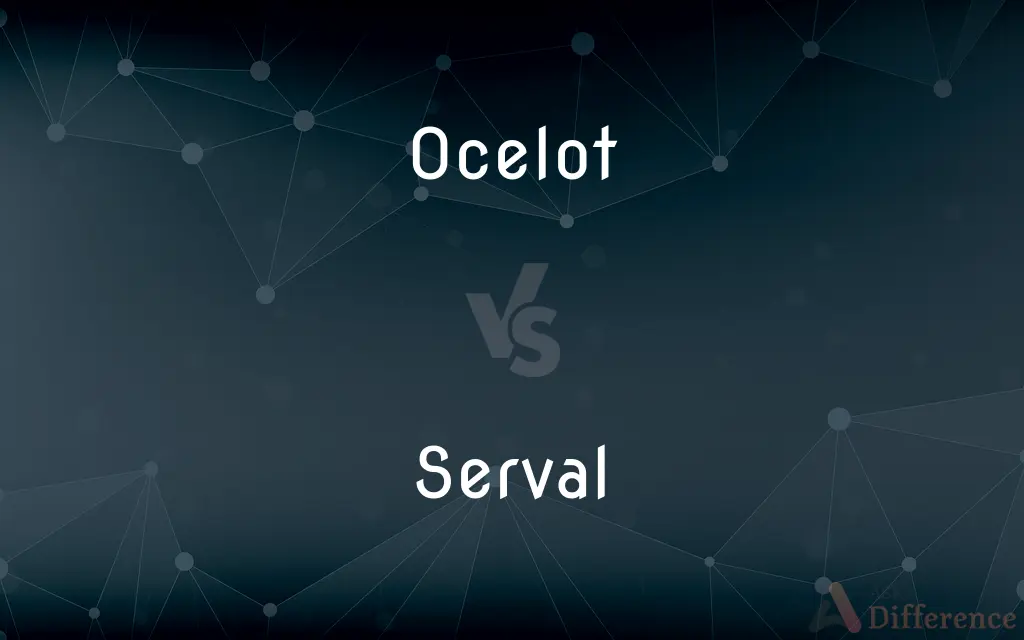Ocelot vs. Serval — What's the Difference?
By Tayyaba Rehman & Maham Liaqat — Updated on April 3, 2024
Ocelots are medium-sized, spotted cats found in the Americas, known for their solitary nature, whereas Servals are African cats, recognized by their long legs and large ears.

Difference Between Ocelot and Serval
Table of Contents
ADVERTISEMENT
Key Differences
Ocelots, native to the Americas, are medium-sized wild cats adorned with distinctive spotted coats, resembling miniature leopards. They inhabit a variety of environments, from arid terrains to dense rainforests, adapting to a wide range of habitats. Their diet primarily consists of small mammals, birds, and fish, showcasing their versatility as predators. On the other hand, Servals are native to Africa, particularly known for their slender physique, long legs, and large ears, which they use to detect prey. Servals predominantly inhabit savannas and wetland environments, where their physical adaptations allow them to hunt more efficiently, preying on rodents, birds, and sometimes fish.
While Ocelots tend to be solitary animals, marking their territory and preferring to hunt and live alone, Servals exhibit similar behavior but are sometimes observed in pairs or small family groups. The social structure of these cats is centered around territory, with both species being highly territorial. However, Servals might share territories with family members, particularly mother-offspring pairs, whereas Ocelots are more strictly solitary, except during mating seasons.
In terms of physical appearance, Ocelots have short, dense fur with patterns that can range from open to closed rosettes and spots, which provides camouflage in their diverse habitats. They weigh between 18 to 40 pounds and have a body length of about 29 to 39 inches. Comparatively, Servals are characterized by their tall, slender bodies, significantly longer legs in proportion to their body size, and large ears, which aid in their exceptional hearing abilities. Servals weigh around 20 to 40 pounds but stand taller than Ocelots due to their leg length, with a body length of about 23 to 36 inches.
The conservation status of both species reflects their adaptability and the threats they face. Ocelots are considered "Least Concern" by the IUCN but face threats from habitat destruction and the pet trade. Servals, also listed as "Least Concern," face similar threats, including habitat loss and hunting for their fur. Conservation efforts for both species emphasize habitat protection and legal protections against hunting and trade.
In captivity, both Ocelots and Servals can live up to 20 years, highlighting their resilience and adaptability. However, their wild instincts remain strong, making them challenging pets. Laws regarding ownership vary, with many regions requiring special permits to keep them. The allure of owning such exotic cats often overlooks the ethical considerations and the complexity of their care in a domestic setting.
ADVERTISEMENT
Comparison Chart
Native Habitat
Americas, from arid regions to dense rainforests.
Africa, primarily savannas and wetlands.
Diet
Small mammals, birds, and fish.
Rodents, birds, and fish.
Social Structure
Solitary, except during mating season.
Mostly solitary, but can be seen in pairs or small family groups.
Physical Features
Medium-sized, spotted coats, 18-40 pounds, 29-39 inches body length.
Slender, long legs, large ears, 20-40 pounds, 23-36 inches body length.
Conservation Status
Least Concern, but threatened by habitat destruction and the pet trade.
Least Concern, with similar threats plus hunting for fur.
Lifespan in Captivity
Up to 20 years.
Up to 20 years.
Compare with Definitions
Ocelot
Has a diet consisting of small mammals, birds, and fish.
The ocelot caught a small rodent, demonstrating its role as a skilled predator.
Serval
Despite its wild nature, it can live up to 20 years in captivity.
The serval in the sanctuary thrives, showing adaptability to life in captivity.
Ocelot
Can live up to 20 years in captivity, though wild instincts remain.
The ocelot in captivity showed its wild nature despite being far from its natural habitat.
Serval
Primarily found in savannas and wetlands, utilizing its physical traits for hunting.
In the wetlands, the serval's large ears detected the slightest movements of its prey.
Ocelot
Faces threats from habitat destruction and the illegal pet trade.
Conservation efforts are crucial to protect the ocelot from further habitat loss.
Serval
Threatened by habitat loss and hunting for its fur.
Legal protections are needed to safeguard the serval from poaching and habitat destruction.
Ocelot
A medium-sized wild cat native to the Americas, known for its solitary nature and spotted coat.
The ocelot, with its distinct markings, prowled through the underbrush in search of prey.
Serval
Diet includes rodents, birds, and fish, showcasing diverse hunting skills.
A serval was seen fishing in a shallow pond, adding variety to its diet.
Ocelot
Adapts to various habitats, from arid regions to dense rainforests.
An ocelot was spotted near the riverbank, highlighting its adaptability to different environments.
Serval
A slender, tall wild cat from Africa, noted for its long legs and large ears.
The serval used its long legs to leap high into the air, catching a bird in flight.
Ocelot
The ocelot (Leopardus pardalis) is a medium-sized spotted wild cat that reaches 40–50 cm (15.7–19.7 in) at the shoulders and weighs between 8 and 15.5 kg (17.6 and 34.2 lb). It was first described by Carl Linnaeus in 1758.
Serval
The serval (Leptailurus serval) is a wild cat native to Africa. It is rare in North Africa and the Sahel, but widespread in sub-Saharan countries, except rainforest regions.
Ocelot
A nocturnal wildcat (Leopardus pardalis) of brush and woodland from southwest North America to central South America, having a grayish or yellow coat with black spots.
Serval
A long-legged African wildcat (Leptailurus serval), having a tawny coat with black spots and very large erect ears without tufts.
Ocelot
An American feline carnivore (Leopardus pardalis, syn. Felis pardalis) covered with blackish ocellated spots and blotches which are variously arranged.
Serval
A medium-sized African wild cat, Leptailurus serval, formerly Felis serval.
Ocelot
An American feline carnivore (Felis pardalis). It ranges from the Southwestern United States to Patagonia. It is covered with blackish ocellated spots and blotches, which are variously arranged. The ground color varies from reddish gray to tawny yellow.
Serval
An African wild cat (Felis serval) of moderate size; - called also serval cat. It has rather long legs and a tail of moderate length. Its color is tawny, with black spots on the body and rings of black on the tail.
Ocelot
Nocturnal wildcat of Central America and South America having a dark-spotted buff-brown coat
Serval
Slender long-legged African wildcat having large untufted ears and tawny black-spotted coat
Common Curiosities
What is an ocelot?
An ocelot is a medium-sized wild cat native to the Americas, known for its solitary nature and distinct spotted coat.
What do ocelots eat?
Ocelots are predators that primarily feed on small mammals, birds, and fish.
Are ocelots endangered?
Ocelots are classified as "Least Concern" by the IUCN but face threats from habitat destruction and the pet trade.
What is the diet of a serval?
Servals primarily feed on rodents, birds, and fish, using their acute hearing to locate prey.
What is a serval?
A serval is a slender, tall wild cat from Africa, distinguished by its long legs and large ears, adapted for hunting.
Where do ocelots live?
Ocelots inhabit a variety of environments across the Americas, from arid regions to dense rainforests.
What habitat do servals prefer?
Servals are primarily found in savannas and wetlands, where their physical traits give them an advantage in hunting.
Can ocelots be kept as pets?
While it's possible, keeping an ocelot as a pet is challenging due to their wild nature and specific care requirements. Laws vary by region.
What step are needed to protect them from destruction?
Legal protections are needed to safeguard the serval from poaching and habitat destruction.
Are servals at risk from human activities?
Yes, servals face threats from habitat loss and hunting for their fur, despite their "Least Concern" conservation status.
Share Your Discovery

Previous Comparison
Aeration vs. Agitation
Next Comparison
Attack vs. ThrustAuthor Spotlight
Written by
Tayyaba RehmanTayyaba Rehman is a distinguished writer, currently serving as a primary contributor to askdifference.com. As a researcher in semantics and etymology, Tayyaba's passion for the complexity of languages and their distinctions has found a perfect home on the platform. Tayyaba delves into the intricacies of language, distinguishing between commonly confused words and phrases, thereby providing clarity for readers worldwide.
Co-written by
Maham Liaqat














































